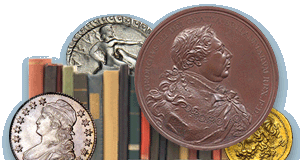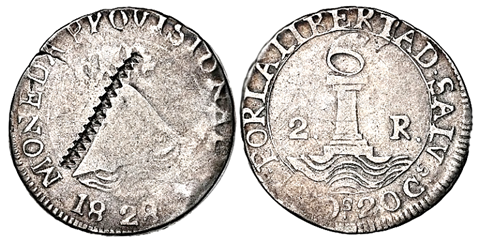
PREV ARTICLE
NEXT ARTICLE
FULL ISSUE
PREV FULL ISSUE
THE EL SALVADOR ZIG-ZAG TEST MARKRoberto Jovel published a paper in the Numismatics International Bulletin, volume 60, number 9/10 on the Zig Zag test mark on El Salvador Provisional coins (1828 through 1835). -Editor Roberto writes: "In recent years, several coins were auctioned that allegedly belong to El Salvador because they bear a ZigZag test mark, and have sold for very high prices. In fact, many of those were not tested and marked in El Salvador, and the persons who bought them find themselves owning pieces that are not Salvadorian. I began researching El Salvador numismatic history in the mid 1990s and have published several books on the subject; after seeing the latest auction sales of the alleged Salvadorian coins, I decided to prepare a paper that tries to set the record straight." To facilitate a wider dissemination of this information, Roberto passed along a copy. With permission, here is an excerpt. Thank you. The complete paper is also available for download from Academia.edu. -Editor A notable curiosity in the historical coinage of El Salvador is the so-called "Zig-Zag" test mark — employed to ascertain the genuineness of individual circulating coins. Having analyzed many coins bearing the Zig-Zag test mark over the past two and a half decades, and noticing many misattributions in recent years, it seems prudent to re-visit the topic at this time to assist numismatists in correctly identifying such coins. Indeed, having published a first book on the numismatic history of El Salvador in the 19th century through 1840, (with editorial assistance from Numismatics International), this writer first identified the official reasons for the presence of the Zig-Zag test mark in the Provisional coins of El Salvador. That publication was followed a few years later by another book in Spanish that covered the numismatic history of El Salvador for the entire 19th Century, which provided additional information on the Zig-Zag test and other Salvadorian counterstamps. Since then, further research and publications by the writer have provided additional information on the various El Salvador and Central American countermarks and counterstamps. International coin auctions over the years have included many pieces that bear the El Salvador Zig-Zag test mark. They have also included some coins that bear a resemblance to the Salvadorian Zig-Zag test mark, but which are not in accordance with the official documentation available, and numismatists have acquired pieces whose marks are not in fact Salvadorian. It seems then, that a careful revision of the subject of the Zig-Zag test mark is in order for the benefit of Latin American collectors. It is important to point out that the Zig-Zag test mark was in fact used during Spanish Colonial times in both El Salvador and Guatemala, as attested by its presence in many pieces of silver jewelry owned by the Catholic Church and private collectors. The Zig-Zag, test mark addressed in this paper, however, refers to the cases where it was used after Independence, during the initial post-independence or republican years.
To read the complete paper, see:
Wayne Homren, Editor The Numismatic Bibliomania Society is a non-profit organization promoting numismatic literature. See our web site at coinbooks.org. To submit items for publication in The E-Sylum, write to the Editor at this address: whomren@gmail.com To subscribe go to: Subscribe All Rights Reserved. NBS Home Page Contact the NBS webmaster 
|
